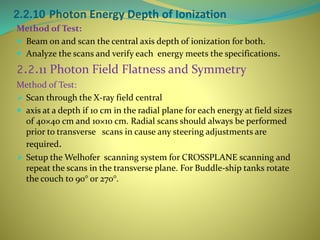Aceeptance testing and commisioning data measurement for photon beam
- 1. Performed By Md. Din Muhammad B.Sc.(Hons.) MPBME Gono Bishwabidyalay, Savar, Dhaka
- 2. 1. Introduction 1.1 General introduction During accepting testing and commissioning medical physicists are faced with many challenges, like a variety of scientific testing methods, setting for highest precision, data accuracy, etc. Accepting testing procedure agreed on between the manufacturer’s representative and the facility physicist Commissioning is a process to prepare machine for any clinical use and investigated, measured, and recorded. Commissioning of a treatment unit should only start after a thorough acceptance process has established its mechanical and radiation consistency.
- 3. 1.2 Objectives of the study The objectives of this study are- To prepare necessary documents for acceptance testing and commissioning. To perform acceptance testing and safety checks Output Calibration of the machine for each photon energy. To measure all relative data required to configure AAA algorithm. To commission the machine for all designated clinical uses To establish treatment procedures and train personnel
- 4. 1.3 Aims & Scopes The main aims of acceptance tests and commissioning are: To assure all specifications are fulfilled. To calculate how much area is free of radiation. To protect the staffs from irradiation. To know how much accurate beam is produced To prepare the machine for clinical treatment To ensure the better quality of treatment
- 5. 2.Materials and Methods 2.1 Materials: There are some equipments that used in my project work . These are: Linear Accelerator(Varian 2300 C/D) Mini Water Phantom (WP34) Cylindrical Ionization Chamber Monitoring Device Geiger Muller (GM) Counters Electrometer(IBA-DOSE-1) Plane-parallel Chamber Film (X-Omat V)
- 6. 2.2.1 Safety Checks Warning lights Door Interlock. Patient monitoring equipment Emergency Buttons Interlocks 2.2 Acceptance Tests Acceptance tests procedures are divided into three groups: Safety Checks Mechanical checks Dosimetry measurements
- 7. 2.2.2Radiation Survey: This test is followed by IEC 61217 protocol Materials: Geiger Muller (GM) Counters 2.2.3 Collimator Axis of Rotation This test is followed by IEC 61217 protocol Materials: Front pointer Graph paper Microspore tape Pinpricks, etc. Method of Test: The graph paper sets under the front pointer tip rotate the collimator from 90° to 270° while observing the pointer run-out .Verify that the worst case run-out ≤1.0 mm. Fig-Collimator Axis of Rotation
- 8. 2.2.4 Gantry Axis of Rotation This test is followed by IEC 61217 and IAEA TECDOC_1540 protocol Materials: Front pointer Microspore tape Pinpricks, etc. Method of Test: Rotate the gantry through 360° angle and visually checking the front pointer run-out after the rotation of every 90°. Fig-Gantry Axis of Rotation 2.2 Acceptance Tests
- 9. 2.2 Acceptance Tests 2.2.5 Couch Axis of Rotation This test is followed by IEC 61217 and IAEA TECDOC_1540 protocol Materials: Front pointer Graph paper Microspore tape Pinpricks, etc. Method of Test: Slowly rotate the Couch from 90° to 270° while observing the front pointer run-out every 45° Verify the worse case run-out is ≤1.0 mm radius for counterweight systems and ≤2.0 mm for Beam-stopper systems. Fig-Couch Axis of Rotation
- 10. 2.2.6 Light Field and X-Ray Field Methods: Set up a piece of film on the Couch with the light field visible on one half of the film sheet. Mark the edges of the light field and expose the film. Shift the film to expose the other half of the film using the same condition for X-ray field. After developing the film compare 50% intensity regions of X-ray edges to the marks representing the light field edges. The difference between the light field marks and the x-ray field edges should coincide within ±2.0 mm. Fig: Light Field and X-Ray Field 2.2.7 Gantry Rotation Spoke Shot Method of Test: Rotate gantry successfully 90 t0 185 for exposed film Bisect 1.0cm exposure Measure the longest line of the trapezoid
- 11. 2.2.9 ODI Calibration Method of Test: Turn on the Field Light and project the crosshairs and ODI rangefinder display on a piece of white paper. Verify the ODI meets specification for the 100 cm position. Drive the Couch 20 cm above and then 30 cm below the 100 cm reference position. Verify the ODI display meets specification.
- 12. 2.2.10 Photon Energy Depth of Ionization Method of Test: Beam on and scan the central axis depth of ionization for both. Analyze the scans and verify each energy meets the specifications. 2.2.11 Photon Field Flatness and Symmetry Method of Test: Scan through the X-ray field central axis at a depth if 10 cm in the radial plane for each energy at field sizes of 40×40 cm and 10×10 cm. Radial scans should always be performed prior to transverse scans in cause any steering adjustments are required. Setup the Welhofer scanning system for CROSSPLANE scanning and repeat the scans in the transverse plane. For Buddle-ship tanks rotate the couch to 90° or 270°.
- 14. Wedge Profile:
- 15. 4. Discussion: The study helps to understand the important of Acceptance tests and commissioning for linear accelerator. The study gives an ideas to improve the work accurately. The study helps the staffs to update their knowledge in this procedures The study helps to measure the errors.
- 16. 5. Conclusion: All measurements are done properly and carefully. All data readings are include carefully. During Absolute and Reference Dosimetry all equipments are setup accurately according to the protocol TRS-398. I could not include some data like beam profiles for both photon energy at all depth ,wedge ,PDD etc. All data are measured before treating the patients.
- 17. THANKS TO ALL
















